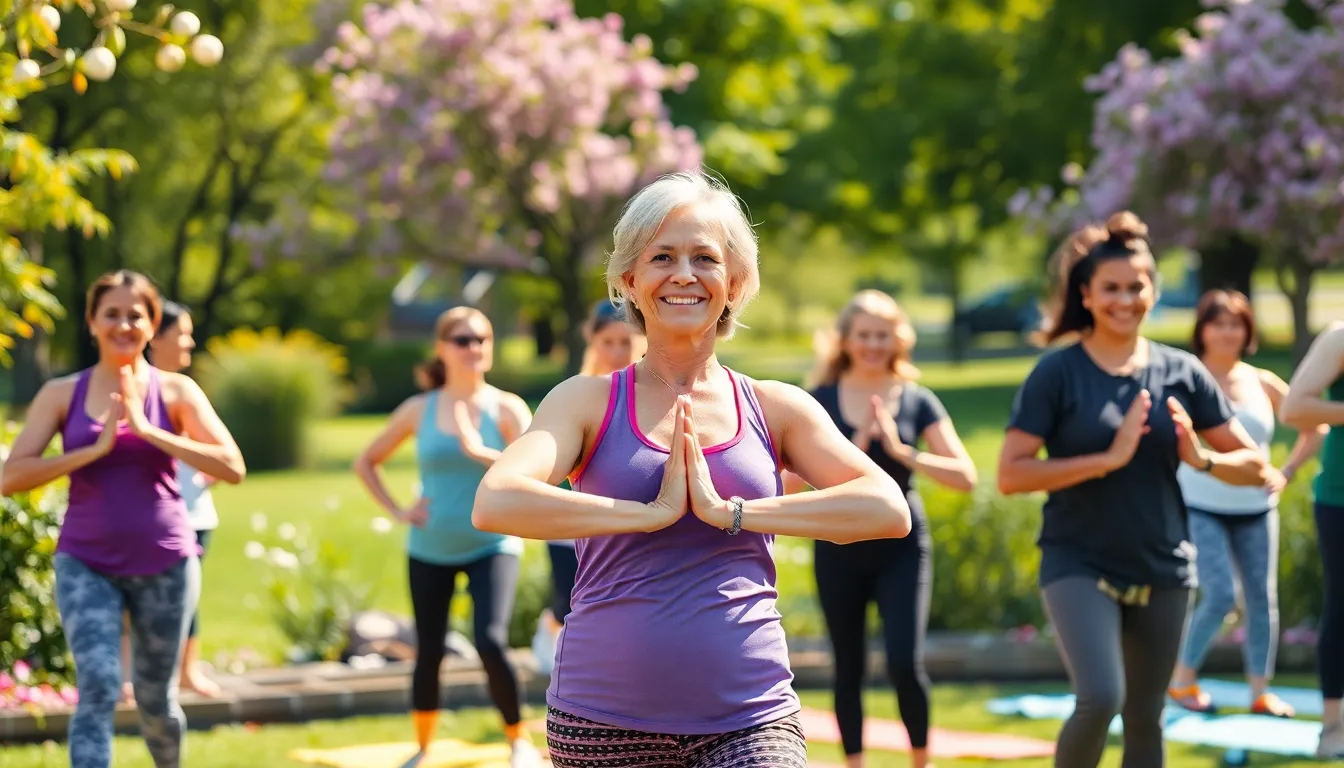Table of Contents
ToggleIn a world where stress levels can rival the height of a skyscraper, community wellness programs are like a refreshing breeze on a sweltering day. These programs don’t just promote health; they create a sense of belonging, turning neighbors into friends and fitness enthusiasts into workout buddies. Who wouldn’t want to swap their couch for a yoga mat and their snack drawer for a veggie garden?
Overview of Community Wellness Programs
Community wellness programs focus on enhancing physical and mental health through collective efforts. These initiatives often include activities such as yoga, gardening, group fitness, and nutrition workshops. Participation in these programs provides individuals with resources for improving their well-being while simultaneously fostering social connections.
Social interaction plays a crucial role in reducing stress levels. Engaging in group activities creates an atmosphere of camaraderie, transforming neighborhoods into supportive communities. Research indicates that social connections positively influence mental health and emotional resilience, which are essential components of overall wellness.
Programs often target specific demographics, tailoring activities to meet the needs of various age groups. For instance, children’s programs might incorporate fun physical activities to promote fitness, while elderly programs often include low-impact exercises and health screenings. Regular participation boosts motivation and adherence to healthier lifestyles.
Community wellness programs frequently involve local organizations and healthcare providers. Collaborations lead to more comprehensive offerings, ensuring access to diverse health resources. By pooling resources, these partnerships improve program quality and outreach efforts.
Funding sources vary, with many programs relying on grants, local governments, and donations. Sustainable financing ensures program longevity and the ability to expand offerings. Feedback from participants typically guides program adjustments, ensuring relevance and effectiveness in meeting community needs.
Overall, community wellness programs serve as effective means to promote health, enhance social connections, and create supportive environments that encourage well-being for all.
Benefits of Community Wellness Programs

Community wellness programs provide various advantages that contribute to overall health and social connection. Participants experience enhanced well-being through physical and mental health initiatives designed to engage every age group.
Physical Health Improvements
Increased physical activity results from community wellness programs. Group fitness activities encourage participants to stay active while enjoying social interaction. Nutrition workshops teach essential dietary habits, leading to better eating practices. Specific programs target diverse demographics, ensuring that everyone can benefit from tailored support. Regular participation facilitates weight management, reducing risks associated with chronic diseases. Improved fitness levels motivate individuals to maintain healthier lifestyles, fostering a culture of wellness within communities.
Mental Well-Being Enhancements
Community wellness programs support mental health through social engagement. Participation in group activities like yoga and gardening reduces feelings of isolation, promoting a sense of belonging. Regular interaction with peers fosters positive relationships, adding layers of emotional support. Workshops focusing on mindfulness and stress reduction equip participants with valuable coping strategies. Collectively, these initiatives significantly boost self-esteem and resilience, leading to improved mental well-being. By nurturing connection, community wellness programs create environments rich in support and understanding, crucial for mental health.
Types of Community Wellness Programs
Community wellness programs encompass various initiatives aimed at enhancing collective health. These initiatives cater to diverse needs and foster a supportive environment.
Preventive Health Initiatives
Preventive health initiatives focus on early detection and risk mitigation. These programs often include screenings for chronic diseases like diabetes and hypertension. Outreach efforts emphasize education on health risks, promoting awareness among participants. Health fairs and workshops facilitate access to vital information. Community partnerships with healthcare providers enhance service delivery, ensuring that residents receive timely and accurate health assessments. Overall, proactive measures reduce long-term healthcare costs and improve community health outcomes.
Nutrition and Fitness Programs
Nutrition and fitness programs provide essential resources for maintaining a healthy lifestyle. Group fitness classes like yoga, aerobics, and Zumba encourage physical activity among participants. Workshops on meal planning and cooking demonstrate healthy eating practices. Access to local gardens promotes fresh produce consumption, fostering better nutrition. Participants benefit from shared experiences and accountability in achieving fitness goals. These initiatives contribute to improved body composition and overall well-being within the community.
Mental Health Support Groups
Mental health support groups play a crucial role in fostering emotional well-being. These groups offer safe spaces for individuals to share their experiences and challenges. Facilitated discussions help reduce stigma associated with mental health issues. Programs often include mindfulness and stress management techniques, aiding participants in developing coping strategies. Connections formed within these groups enhance social support networks, encouraging resilience and emotional growth. Long-term engagement in these initiatives leads to a more mentally healthy community.
Success Stories of Community Wellness Programs
Community wellness programs have shown significant success in various settings. In one notable case, a program in Seattle improved participants’ physical health by facilitating regular outdoor group workouts. Through these organized sessions, local residents increased their average weekly physical activity levels from 80 minutes to 150 minutes, demonstrating the program’s impact.
Another example comes from a Chicago initiative that focused on nutrition education. Participants in this program reported a 30% increase in their knowledge of healthy eating habits after completing a series of workshops. These changes translated into improved dietary choices, with a notable shift in the number of individuals increasing their daily fruit and vegetable intake.
In addition, a mental health support group in San Francisco successfully reduced feelings of isolation among its members. Attendees reported feeling more connected to their community, leading to a 40% decrease in reported anxiety levels over six months. This illustrates the importance of social support within wellness initiatives.
Furthermore, collaborative efforts between local healthcare providers and wellness programs in Austin led to significant health improvements. Routine screenings and education resulted in early detection of chronic diseases for over 200 individuals, allowing for timely medical interventions.
Programs in Miami that combine fitness with mindfulness practices have also yielded positive outcomes. Participants noted an impressive 25% increase in their overall well-being scores after participating in yoga and meditation sessions.
Together, these success stories highlight the effectiveness of community wellness programs in enhancing health and fostering a sense of belonging among residents. They serve as powerful examples of how targeted initiatives can lead to meaningful changes within communities, ultimately promoting sustainable health improvements.
Challenges Facing Community Wellness Programs
Funding poses a significant challenge for community wellness programs. Many of these initiatives rely on grants, donations, and local government support, making financial stability unpredictable. Underfunding can limit the scope of programs and reduce their effectiveness.
Community engagement also presents hurdles. Some individuals remain unaware of available resources or might not prioritize participation due to other commitments. Engagement strategies must align with community needs to maximize involvement and impact.
Sustaining participant motivation can become difficult over time. Programs may experience initial enthusiasm, but maintaining long-term interest often requires innovative activities and consistent communication. Regularly refreshing the programming keeps individuals engaged and fosters commitment.
Access to resources represents another barrier. Geographic locations lacking transportation infrastructure may hinder participation, especially for vulnerable populations. Programs need to consider transportation solutions or virtual options to increase accessibility.
Cultural relevance plays a crucial role in program effectiveness. Communities are diverse, and wellness initiatives must resonate with varying cultural backgrounds to be inclusive. Programs not addressing these differences might encounter resistance or low engagement.
Evaluation and measurement of success can prove complex. Programs must implement effective tracking and evaluation methods to assess impact accurately. Without clear data, it becomes challenging to demonstrate benefits to stakeholders or secure ongoing funding.
Recruitment and retention of qualified staff and volunteers may hinder progress. Community wellness programs require dedicated personnel to design and execute effective initiatives. Competing for skilled individuals with other organizations can strain resources and limit growth.
Challenges persist, but addressing these issues can enhance the impact and sustainability of community wellness programs. Solutions often involve collaboration with local organizations, innovative funding strategies, and community outreach tailored to diverse populations.
Community wellness programs play a vital role in enhancing health and fostering connections among individuals. By promoting physical activity and mental well-being, these initiatives create supportive environments that encourage participants to thrive. The success stories from various programs demonstrate their effectiveness in improving health outcomes and reducing isolation.
Despite facing challenges like funding and engagement, the potential for positive change remains significant. With innovative strategies and community collaboration, these programs can continue to evolve and meet the diverse needs of their participants. Ultimately, investing in community wellness initiatives not only benefits individuals but strengthens the fabric of entire communities.






